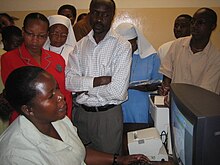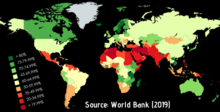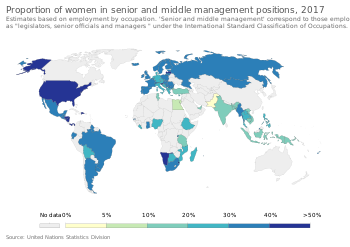
Back المرأة في القوى العاملة Arabic Qadın əməyi Azerbaijani শ্রমিকদের মধ্যে নারী Bengali/Bangla Frauenarbeit German Lana eta emakumea Basque زنان در نیروی کار Persian Travail des femmes French Կանացի աշխատանք Armenian 働く女性 Japanese Әйел еңбегі Kazakh
This article is missing information about pre-Modern era. (June 2020) |



Since the Industrial Revolution, participation of women in the workforce outside the home has increased in industrialized nations, with particularly large growth seen in the 20th century. Largely seen as a boon for industrial society, women in the workforce contribute to a higher national economic output as measure in GDP as well as decreasing labor costs by increasing the labor supply in a society.
Women's lack of access to higher education had effectively excluded them from the practice of well-paid and high status occupations. Entry of women into the higher professions, like law and medicine, was delayed in most countries due to women being denied entry to universities and qualification for degrees. For example, Cambridge University only fully validated degrees for women late in 1947, and even then only after much opposition and acrimonious debate.[1] Women were largely limited to low-paid and poor status occupations for most of the 19th and 20th centuries, or earned less pay than men for doing the same work.[2] However, through the 20th century, the labor market shifted. Office work that does not require heavy labor expanded and women increasingly acquired the higher education that led to better-compensated, longer-term careers rather than lower-skilled, shorter-term jobs. Mothers are less likely to be employed unlike men and women without children.[3]
The increasing rates of women contributing in the work force has led to a more equal disbursement of hours worked across the regions of the world.[4][failed verification] However, in western European countries the nature of women's employment participation remains markedly different from that of men.
Increasing women's equality in banking and the workplace might boost the global economy by up to $28 trillion by 2025.[5][6][7]
- ^ [1] Archived November 7, 2007, at the Wayback Machine
- ^ Burnette, Joyce; Stanfors, Maria (March 2020). "Understanding the Gender Gap Further: The Case of Turn-of-the-Century Swedish Compositors". The Journal of Economic History. 80 (1): 175–206. doi:10.1017/S002205071900086X. ISSN 0022-0507. S2CID 213712971.
- ^ "Statistical Overview of Women in Global Workplaces: Catalyst Quick Take". Catalyst. Retrieved May 20, 2021.
- ^ "Graph". Gapminder World. Retrieved February 17, 2015.
- ^ "How advancing women's equality can add $12 trillion to global growth | McKinsey". www.mckinsey.com. Retrieved February 28, 2023.
- ^ "Women's solutions stories create a world where everyone thrives". European Investment Bank. Retrieved February 28, 2023.
- ^ Feloni, Richard (March 8, 2019). "If we closed the gender gap by 2025, the global economy could see a $28 trillion windfall". Business Insider Nederland (in Dutch). Retrieved February 28, 2023.